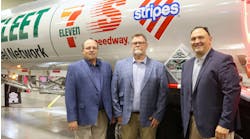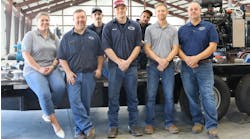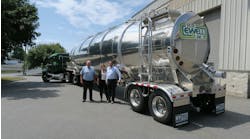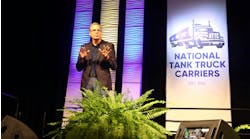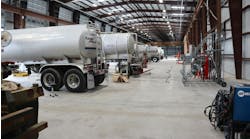Alaskans, whose home is as vast as it is beautiful, often are described as self-reliant, resilient and resourceful.
Their trucking businesses and fleets must be equally rugged to endure the state’s harsh market conditions, including shortened peak hauling seasons, extreme weather and roads, and fewer potential customers.
And that’s how you know Jimmy Doyle’s as tough as they come.
His family’s transportation businesses, including Weaver Bros Inc. (WBI)—which they’ve owned and operated for more than 40 years—have survived and thrived in Alaska since 1962. Next year marks the 60th anniversary of Doyle’s Fuel Service (DFS), which delivers diesel and gasoline products to customers in the Kenai area.
One of WBI’s original lines of work—dating to the 1940s, through three owners—was asphalt hauling for the road construction industry. The company remains a major player in the business today, and Doyle’s thankful it’s so. That segment has remained strong, while others, including oilfield services, have suffered during the pandemic.
To withstand the mercurial cargo climate, WBI maintains a versatile fleet that’s capable of serving customers in the construction, energy, mining, retail and wholesale, and government sectors, among others; purchases and maintains all of its own equipment, to ensure long-term, debt-free service; and only deploys dependable trucks that last—as evidenced by a vintage fleet of Kenworths that spans 10 decades.
WBI also keeps a close watch on safety, helping it secure a second Grand Award in National Tank Truck Carriers’ 2020 North American Safety Contest.
“Just like most other companies that have been around this long, we’ve been through a number of cycles … and different times when work was down, so we’re a very conservative company,” Doyle said. “Everything we have is paid for. Nothing’s financed. So when it does slow down, one thing we don’t have to worry about is paying for equipment.
“And so far, for the most part, we haven’t had to lay anybody off, but as they retire or move away, or something happens, for whatever reason, we’re trying to improve our processes, so we don’t need to rehire. So we’ve downsized that way.
“Prior to the pandemic, we had probably 130 to 140 people, and we’re down to about 120 employees right now.”
Oregon trail
The original Weavers, who founded Weaver Bros. in 1946, were from Oregon. In the earliest days, brothers Howard, Ken and Russ Weaver would head to Alaska during the summers to haul liquid asphalt for road-building companies. In 1955, they moved their main operations to Anchorage, and they sold the company to Neil Bergt in the mid-1970s.
Jimmy’s father, Jim Doyle, bought the business, and its Interstate Commerce Commission and state operating authorities, from Bergt in October 1978. So Jimmy, now 61, grew up around trucking. He was washing DFS trucks as soon as he could hold a sponge, and piloting them at 16, before a commercial driver’s license was required.
“From the time I was 10 or 11 years old, I would ride with my dad whenever I could,” he recalled. “I still drive whenever they need me to, on linehaul, usually to Kenai, Seward or Homer. I do that whenever we need extra drivers. So it’s something I’ve enjoyed since I was a little kid, having been raised around truckers.”
He rejoined those knights of the road in 1980 after graduating college, first as a driver and later as a dispatcher at the family’s original Kenai terminal. Then, in 1985, he relocated to Anchorage to run WBI as vice president—a title he still holds today, as Jim remains president in the Kenai office. However, at 86 this summer, he’s turned over many duties to Jimmy.
The family business also includes Jimmy's sister, Shari Doyle, and a cousin, Kevin Doyle, who help run the operation in Kenai; and Jimmy's wife, Sharon, an office manager, and daughter Jenna Efird and her husband, Randy Efird, who are part of the Anchorage team.
Today, the company maintains terminals in Kenai, Anchorage and Fairbanks, Alaska. Its diverse fleet of 130 trucks and 500 trailers includes liquid tank trailers for carrying asphalt, fuel and chemicals; pneumatic dry bulk trailers for powder cement, drilling muds and other commodities; refrigerated and dry van trailers; lowboys and flatbeds; and “high-lift” trucks, among many other specialized vehicles.
Key customers include Matson and TOTE, which move goods via ship from Tacoma, Washington to Anchorage; Chevron, Holiday and Marathon, which have gas stations in Alaska; Carrs-Safeway, which operates one of the state’s two largest grocery chains; and Quality Asphalt Paving, Granite and Pruhs in the construction industry. WBI also serves Hilcorp in the oilfield, Univar and Cryotech in the chemical business, and delivers fuel to airports.
Local drayage makes up the largest portion of the overall operation, Jimmy said.
Asphalt business
Since the Doyles acquired Weaver Bros. in the fall of 1978, one of their first experiences with the business involved hauling asphalt from a Chevron plant in Kenai to customers throughout Alaska the following spring. Peak road-building season there runs May to October, when the weather becomes less cooperative, and asphalt is the preferred material because concrete doesn’t fare well with dramatic temperature fluctuations.
“We don’t have roads in Alaska made out of concrete like folks do in the lower 48,” Jimmy said. “Everything here is asphalt. So for that short construction season, companies are doing as much paving as they can.” To service those companies, WBI maintains 50 insulated, hot oil trailers for transporting asphalt between 350 and 400 degrees F, 30 pneumatic tankers for cement, and lowboy and step-deck trailers for hauling paving equipment.
WBI was one of the first companies in Alaska to use doubles for hauling asphalt. Their preferred configuration is a four-axle lead trailer, with one axle in the center and three in the back, joined with a two-by-two, four-axle pup trailer. The combination is more than 120 feet long, with a gross vehicle weight of 145,000 pounds.
WBI’s typical asphalt double can deliver up to 90,000 pounds of product in one trip.
“For years, you weren’t allowed to haul doubles in the state,” Jimmy said. “The roads weren’t wide or straight enough to make sure they were hauled safely. And so us and a couple other companies were part of a pilot program to run doubles in certain locations, and one of the first things we did was run asphalt doubles.”
Now the setup is common in the sparsely populated state, where axle weight limits are higher than in the lower 48, allowing carriers to deliver larger payloads across greater distances during shorter hauling seasons—which WBI continued to do during the 2020 construction-hauling season, which Jimmy says was not slowed by the pandemic.
“I don’t know of any jobs that were cancelled,” Jimmy said. “But a lot of times the road-building jobs in Alaska are a two- or three-year deal, because they usually can’t move all the dirt and get all the paving done in one season. So you end up completing part of the work one year, and the rest the next year.”
That means COVID’s true impact on Alaska’s road-building efforts might not be felt until a year or two down the road. But Jimmy is hoping any potential slowdowns are offset by the infrastructure bill currently working its way through Washington.
“If that gets passed, we hope and assume that Alaska will be receiving some funds, and it should help,” he said. “The roads in Alaska, because of the extreme weather patterns you have, between freezing and thawing, don’t last 20 years, like they might in the states. You’ll go back and repave the same road you already did maybe five or 10 years later. Sometimes the road's already improved, so all they’re doing is redoing the pavement, and sometimes they’re going back and widening or straightening the road, and it’s a bigger job.
“But we have to repave on a pretty regular basis.”
Equipment upkeep
WBI’s asphalt haulers are a mix of Beall, Etnyre and Heil trailers.
The company also runs Heil dry bulk trailers, and maintains MC-306/DOT-406 liquid tank trailers from Clough, Fruehauf and Trailmobile. Chemical trailers are used for transporting Sulfuric acid, caustic soda and hydrochloric.
The newest refined tankers ordered were 12,000-gallon, five-axle trailers. WBI’s fleet includes approximately 90 total tank trailers, and 80 ISO tank containers that support the oilfield business.
Most trailers feature Hendrickson air suspensions, but WBI still specs drum brakes on its refined tank trailers. “Up here, we have a lot of problems with getting stones in disc brakes,” explained shop supervisor Larry Newell, who said rocks and pebbles get lodged between the calipers and rims, causing rim failure. Dirt and debris even knock off valve stems, and tear up tire pressure monitoring systems, so the company avoids those as well.
WBI runs with ConMet hubs and Michelin tires on new trailers and trucks—which do feature disc brakes—along with Blackmer pumps for moving liquid product. New tankers are spec’d with lighting from Truck-Lite.
The carrier’s three shops are manned by 12 total mechanics. The Doyles’ original Kenai location includes a tractor shop often used to store trucks in winter months. Kenai’s trailer shop features five bays, plus designated areas for ISO tank and chassis work.
Fairbanks features two drive-through truck bays, and the Anchorage shop boasts four drive-through bays, and two short bays for service and engine work. That location is R-stamp certified by the National Board of Boiler and Pressure Vessel Inspectors for cargo tank repairs.
Each location domiciles its own fleet. “It’s easier to have all your inventory in one spot when you have to fix the stuff,” Newell said.
Stringent preventative maintenance cycles call for grease jobs every 5,000 miles and oil changes every 10,000 miles to ensure equipment survives the heat generated by ultra-heavy loads during Alaskan summers. WBI uses Samsara equipment monitoring to make sure trailers are scheduled for service every 5,000 miles.
The newest Kenworth trucks, featuring Cummins engines and Eaton automated manual transmissions, come from Papé Kenworth Alaska. WBI put a new Kenworth W900 into service last fall, Newell said, and added three T800s to Fairbanks’ fleet this spring. The company started spec’ing AMTs in its daycabs in 2015.
Kenworth collection
Jimmy said his dad started buying Kenworth trucks in the 1960s because they’re tough enough to withstand Alaska’s extreme weather and road conditions, thus maintaining their utility—and value—for the long haul.
“That was something he recognized right away,” Jimmy said.
Jim bought his first, factory-fresh Kenworth in 1968 for $25,000. He drove it into the late 1970s, and then Jimmy drove it for one year. The truck now has more than 600,000 miles on it, and he says it’s still comfortable to drive, despite the older suspension. Jimmy’s first truck was a 1975 wide-nosed Kenworth W900 model.
Both vehicles are in the family’s impressive Kenworth collection covering nearly 100 years.
The oldest truck is a 1932 Kenworth Jim bought in the ’80s from a former transportation company owner who intended to restore the truck, but never got around to it. The truck was one of the first Kenworths put to work in Alaska hauling freight out of Valdez, where most goods arrived back then. When Jim went to restore the vintage vehicle, he called Heiser Body Company—which he later learned was the cab’s original manufacturer.
“They figured out, when they pulled the truck apart, that Heiser Body Company had produced the cabs for Kenworth back in the ’30s, so their grandfather, Mr. Heiser, actually built that cab,” Jimmy said. “They were able to tell by looking at the data plate, which showed who was the manufacturer, and it was Heiser.”
Around the same time, Jim located Kenworths from the 1940s and ’50s. He was particularly excited about the ’40s-era finds—which turned out to be old Weaver Bros. trucks. “We contacted the owner, and we were able to get two of them,” Jimmy said. “One’s a ’46 and the other’s a ’49, and they’re part of a set we’re combining into one. They’d been sitting out in the weather for 60 years, so they were in rough shape.”
Because the family’s been in business since the ’60s, they already had trucks from the ’70s and ’80s, and they’ve continued to buy Kenworths over the years—all the way up to WBI’s first 2020s truck added 18 months ago. “That’s when we started doing the math and realized we have trucks from 10 different decades,” Jimmy said. “Some of those trucks are still being used. And we’re in the middle of restoring the ones from the ’40s and ’50s.”
The pandemic extended the timeline, so the goal now is to have representatives from each decade fully revitalized by the middle of 2022—at which time WBI will host a celebratory reveal. They’re also looking for ways to display the collection, and have reached out to the local Kenworth dealer to gauge the OEM’s interest.
“You can really see the Kenworth truck’s evolution when you see the entire collection,” Jimmy said. “From the ’68 model, which had torsion bars, to where now everything has an air ride suspension—and even the cab’s air ride—they really have done a good job of working to improve the comfort for the driver, and giving them space. The cabs are bigger, the visibility is better—from having two flat windows to a curved glass window—the ride is so much better, and of course the technology has helped drive all that.”
Road to safety
As the Doyle family works to finalize a museum-quality fleet, they’re keeping a close eye on safety—and the road ahead.
That could include WBI’s first Heil Trophy.
As a Grand Award winner, the Alaska carrier is in the running for NTTC’s most prestigious North American Safety Contest honor, which annually is presented to North America’s two safest tank truck fleets—one in the Harvison division, for carriers with fleet that cover more than 15 million miles, and one in the Sutherland division, for carriers with less than 15 million miles, which includes WBI’s operation.
The winners will be revealed during NTTC’s Annual Conference June 13-15 in Indianapolis, Indiana.
“That’d be very rewarding,” said Dan Jurusz, WBI’s HSE manager.
Weaver Bros. also is a seven-time Alaska Trucking Association Safe Fleet of the Year award winner, and five-time recipient of the “Best Risk Control Program” award from the company’s insurance group, which includes about 40 members who are ranked each policy year based on a thorough safety performance assessment.
The latter accomplishment, repeated in 2020 and 2021, is more impressive considering the challenging conditions WBI drivers regularly encounter.
“Our highway system consists mainly of two-lane mountain roads,” Jurusz said. “We don’t have very many divided highways built to interstate standards like in the lower 48. And on these roads, we’re often pulling doubles. So there are challenges in the way the road is laid out, in terms of grade and curves drivers must be on top of, and limited road maintenance in the mountainous areas. There are a lot of times drivers will have to chain up to go over a mountain pass. There’s also wildlife to deal with, and there’s a big difference between hitting a deer and hitting a moose. A moose hits you a lot harder. If you hit a moose at highway speed, and you don’t have a ‘moose bumper’ … you can expect the truck to come back on a hook.”
That’s why all of WBI’s linehaul trucks are equipped with HERD truck guards.
Their trucks also feature Samsara cameras, which help WBI improve its safety scores through driver coaching, and lower its insurance premiums through exonerations in post-accident, he-said, she-said situations. When cameras show a collision wasn’t the truck driver’s fault, they also get repairs paid for faster, Jurusz maintained. “After the last incident we had, I met the driver and police officer at the scene, and showed the officer the video on my phone, and he wrote the other driver a ticket based on that, and I was paid for the damages to my truck by the other insurance company within three weeks,” he said.
WBI also recently implemented a behavior-based safety program that includes a bonus structure designed to reward drivers, mechanics and other employees who report unsafe conditions, and then also take the initiative to help correct the problem as quickly as possible—even if it’s at a customer’s facility.
"All the employees who embrace our culture of doing it safely are the key to our success," Jimmy said.
Steady resolve
Combined, WBI and DFS generated close to $30 million in revenues in 2019. They dipped below $25 million last year, Jimmy said, after losing 15% of its oil and gas work during the pandemic—business he fears isn’t coming back.
WBI’s gas station segment used to provide work for 13 drivers. Now they’re down to 10 after that piece alone lost 30% of its revenue.
To compensate, the company’s searching for new ways to keep trucks on the road.
“If I was in the states, and I owned and operated in Washington state, for instance, and wanted to grow my business, I would look in Idaho or California or Montana,” Jimmy said. “Here, you don’t have that ability. We’re in a fishbowl, so to speak. So what we try to do is simply make ourselves competitive, and go out and knock on customers’ doors we haven’t knocked on before. For the longest time, the business was growing organically on its own, and now we’re out looking for customers who we haven’t serviced in the past.”
Fortunately for WBI, its fleet is robust—and its business, which has survived many previous downturns—is resilient.
Just like the Alaskan people.
“Usually, after a down cycle, when activity starts going back up again, there’s an opportunity to do something different we’ve never done before,” Jimmy said.
